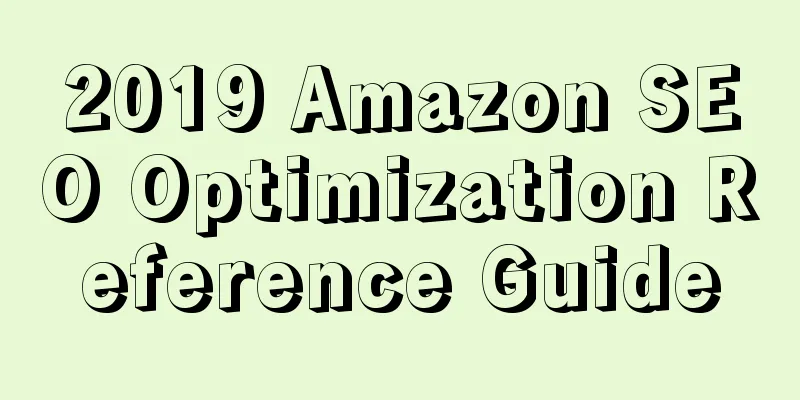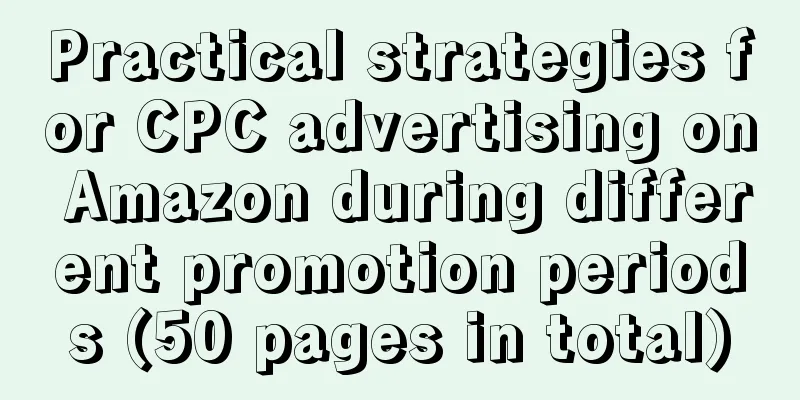2019 Amazon SEO Optimization Reference Guide

|
As more and more sellers enter Amazon, market competition becomes increasingly fierce. This means that sellers must bring out their best cards if they want to win the competition, and SEO optimization is the key chip. However, Amazon's search engine (i.e., the A9 algorithm) makes people love and hate it. On the one hand, it can analyze the user's usual purchasing habits and preferences when the user purchases related products, so that sellers can respond accordingly. On the other hand, Amazon frequently and unpredictably updates the algorithm, which often frustrates most sellers. Because as the new algorithm changes, sellers have to update their product pages accordingly. Therefore, the opinions and suggestions in this article may change as the Amazon A9 algorithm evolves. Even the best SEO software and tools cannot predict the future. This article is of certain reference value to Amazon sellers who are at a loss when encountering SEO optimization problems. Before you start doing Amazon SEO optimization, you should remember this: Amazon focuses on the buyer's shopping experience and rights. It sounds simple, but if you can keep this in mind when optimizing your Amazon product listings and weigh the interests between you and the buyer, the decisions you make will help increase product sales. The difference between Amazon's A9 algorithm and Google search or other advanced search engines is that Amazon is primarily a shopping platform. As consumers, we rarely go to Amazon just to browse and not buy, and Amazon knows this. So it constantly updates its algorithm and continuously analyzes and tests consumer purchasing behavior. Therefore, as a seller, you also need to constantly update product information to surpass your competitors, increase product visibility, and thus increase conversion rates. In addition, we need to keep in mind the purpose of Amazon’s A9 algorithm when planning to convert potential customers into real customers. Here are three aspects to consider when optimizing Amazon listings:
Remember: Amazon cares about the buyer's shopping experience and rights.
The Amazon search engine algorithm (i.e. A9) is a mature algorithm that will become more sophisticated over time, but for now, its keyword search approach seems to be very simplistic and the search results do not match the query well enough. The following examples will give you an idea of how the A9 algorithm works: I want to find multivitamins from Dr Tobias (the best-selling fish oil brand in the US and Asia), so I type "Dr Tobias multivitamin" into the Amazon search box, and the following three precise results appear:
However, once you add the word Bryan (name) to the search box, no accurate search results will appear because the product listing does not include this word. However, since Amazon updated its algorithm last year, related products will still appear even if the word entered is incorrect, as shown in the figure below:
For another example, after typing in just “multivitamin”, the following number of search results were displayed:
In the past, if you typed a word slightly differently, the search results would be completely different. Last year, Amazon improved their algorithm, including word inflection. So now, even if you type a word slightly differently, you can still get similar search results. For example, replace the word above with "multi vitamin":
What does this mean? First, the A9 algorithm has become smarter. Second, you still need to fill in as many relevant keywords as possible, including the possibility of various variations and spelling errors, to increase Listing visibility, sales, and overall ranking of search results. Basically, you need to optimize for the following three aspects:
Simply put, you have to get customers to see your product and click on your product link. Next, let’s take a look at the various components of a product listing and how we can optimize it. Search ranking factors:
Title composition The listing title is the most valuable part of your product detail page. The quality of the title directly affects the product's search results performance. According to Amazon's best practices, the title should include the following components:
The key to creating a quality title is to rank these elements with additional target keywords (another major ranking factor). According to the experience of e-commerce leaders, how to choose keywords and how to sort these keywords will greatly affect the sales and ranking of products. Keyword sorting In the picture below, do you notice anything different about the SP ad slot?
Yes, the number of characters in the title varies! Titles in organic search results are typically 115-144 characters long (depending on the category). The headline in the right column ad is approximately 30-33 characters, and between 55-63 characters on mobile devices. This means that first we must put the most relevant keywords at the top. This is done to ensure that no matter how the search results page ranks, every customer can accurately understand the products that the seller is selling. In addition, the Amazon A9 algorithm prefers keywords that are placed earlier in the title. Therefore, it is recommended that you put the most important keywords first in the title and arrange these keywords strategically before each character in the title. One of the most common questions sellers ask is: Should the brand name be included in the title? Regarding this question, you should test your own products to see which one converts best. After all, retailers build customer relationships more through brands rather than through some general product attributes. But remember this: don’t stuff keywords into your title! Keyword stuffing has been a strategy used for several years, but Amazon’s policies are completely different now. Consumers and Amazon should be aware of this: blindly stuffing keywords will have an adverse effect on sales. Whether your product listing is new or old, you have the opportunity to optimize and adjust it to gain higher visibility and sales. If it is a brand new listing, you will not have any product data to rely on. You can use keyword tools to help you find keywords that convert well. In addition, you can refer to your competitors’ product listings to determine the best keywords and placement order. Here are the specific steps for title optimization: Steps to Optimize Amazon Product Titles 1) Research the two to three most popular keywords for your product using the keyword research tool Helium 10-Magnet.
2) Use Keyword Inspector to reverse search the ASINs of your main competitors.
3) Try to select the top three listings with the highest reviews. The more reviews, the longer they have been selling, and the more data you will be able to get from them. Once you have the data, combine them or remove all search terms that are not related to your product. Then, write your title with the help of word and term frequency counters. To ensure that the title reads smoothly and covers all basic product information and target keywords, you can use the following four special characters to separate adjacent keywords:
4) Finally, make modifications based on the listings of your best competitors.
The bullet points in the listing are a great opportunity to showcase the features and benefits of your product. The bullet points will not directly affect the ranking of the product in search results, but they can affect conversion rates and product relevance . Although most sellers are aware of this, they often confuse product features with product benefits. For example, leather seats should be a product feature, while the benefits are luxury and comfort. In addition, like the title, the keywords used in the five-point description will also be included in the A9 algorithm index and become one of the matching elements presented in the results when customers search for products. Bullets optimization suggestions:
Similar to bullets, product descriptions do not directly affect rankings. However, their content is also included in the index and affects the exposure of listings. In addition, a good ad copy with an eye-catching CTA button will greatly increase conversion rates. Product description optimization suggestions:
Sellers can enter more long-tail keywords or hot search keywords here. For example, for sellers selling sleeping bags, you may not be able to add words like "…for camping that fits 2 big-boned people" in the description, but you can add the sentence to the background keywords. Sellers can also add some non-English expressions, incorrect spellings, and common phrases in the product niche in the backend keywords. For example, sellers selling pet dog peripherals can add 50-100 pet dog names, because most consumers are more direct and specific when searching for products, so your products have a better chance of being searched. You can use the listing optimization tool to pick out keywords that have not yet been included in the title, bullets, and product description. You don’t have to separate the keywords with commas, you can use spaces. Also note that these keywords do not need to be copied and pasted into the product listing.
1) Sales volume is king Nothing drives search rankings more than sales volume and sales velocity. Similarly, a surge in competitor sales will greatly affect the store ranking. According to statistics, only 30% of customers click to browse the second page, let alone the third and fourth pages. Here are some suggestions for boosting sales: First of all, the first step of SEO optimization is to introduce both on-site and off-site traffic to your product listing. You can introduce in-site traffic through Amazon PPC advertising, and introduce off-site traffic through Facebook advertising, Google AdWords, etc. Secondly, you can use the Launch service, which is a new product booster that combines a promotion platform with an email review invitation system, which naturally increases sales and product rankings. Of course, you must choose a compliant Launch service. 2) Review wins Review is the "magic weapon for success". Why do you say that? Because consumers usually rely on store reviews to decide whether to buy a product. In addition, product reviews can also serve as social proof, making buyers feel at ease to buy products. In addition, reviews can seriously affect the ranking of products in search results. Many products have considerable sales after launch but no reviews. In this case, the product ranking is at most on page 5. But once there are two product reviews, the product ranking may jump to page 2. Therefore, some sellers will obtain product reviews through non-compliant channels. Through some services, buyers can post false positive reviews in exchange for compensation. This is why Amazon has been cracking down on fake reviews, so how to obtain reviews through compliant channels has become the primary consideration for many sellers. First, sellers can communicate with customers through the Seller Messaging Service in the Seller Center. Sellers can also use professional tools such as Feedback Genius and Sales Backer to automatically write custom email sequences, better build customer relationships, and seek objective and legitimate product feedback and reviews. If you want to launch a discounted product campaign to generate sales and reviews, you can try Snagshout . We also observed and summarized 5 other influencing factors, which are not officially recognized by Amazon, but seem to have an impact on SERP. Therefore: 1) Use Amazon FBA to ship All else being equal, products shipped using Amazon FBA appear to rank higher than products shipped through Merchant. 2) Use your brand name in your Amazon product listing Having keywords in your brand name helps improve your organic ranking in searches. 3) Add the seller's name If the seller name is related to the main keyword of the product, it may help improve the organic ranking. 4) Fill in all appropriate fields on the Edit Product page Make sure to fill out all appropriate fields on the edit product page, as some of these fields have been shown to affect ranking and filtering results. 5) Use multiple high-quality photos Images that can be enlarged or reduced greatly affect product conversion rates and search result rankings. In addition, it seems that the more product images there are, the higher the search result ranking.
Yes. While Amazon is an e-commerce platform, it is also a search engine. In many cases, buyers use Amazon to compare prices and find products they want to purchase. Sellers also often use Amazon to conduct market research when deciding to update a product. Additionally, with the introduction of Alexa by Amazon, Amazon website data is often used to answer voice searches. Amazon doesn’t typically announce when they update their search algorithms. Therefore, it is impossible to tell how often Amazon’s ranking algorithm changes. But fortunately, the core algorithm has remained relatively stable. SERP is the abbreviation of search engine results page, which is the result displayed to users after completing a product search on Amazon, that is, the Amazon product search results page.
When you encounter Amazon SEO optimization problems, you can take corresponding practical actions to deal with them through this article. I hope this article will be helpful to you.
Text ✎ Mary/ Statement: When reprinting this article, the title and original text must not be modified, and the source and original link must be retained. |
<<: Amazon e-commerce tycoon shares his experience, why not save it?
>>: How to think about Amazon Listing optimization from the buyer’s perspective?
Recommend
Customs strictly checks! Many freight forwarders urgently suspend receiving all epidemic prevention products!
The General Administration of Customs issued Annou...
Guide to hot-selling products on Shopee Malaysia during the epidemic
Hot-selling products on Shopee Malaysia during the...
American college students love to shop on Amazon! These are the categories they often buy
It is learned that according to foreign media repo...
The US consumer market is picking up! Online e-commerce is growing significantly
Recently, an overseas data agency released the lat...
Top 10 Reasons Why Amazon Accounts Can Be Blocked
As the world's largest e-commerce platform, A...
State Council: Small and medium-sized enterprises are exempted from three social insurance taxes for five months
The social security issue that small and medium-si...
Shocked! Shenzhen's popular store was frozen by Amazon, with bad debts exceeding 10 million
The May Day holiday has just passed, but the Shenz...
What is airuntech-products? airuntech-products review
airuntech -products is dedicated to fitness sports...
What is Shoesbuy? Shoesbuy Review
Shoesbuy is an online shoe merchant that mainly se...
What is TUV certification? TUV certification review
The TÜV mark is a safety certification mark specia...
US anti-counterfeiting organization issues fake goods warning! Amazon, Walmart and other platforms are named
It is learned that on December 15, the US anti-cou...
Big event of the week! Online spending on Thanksgiving in the U.S. exceeded $4 billion for the first time
LightInTheBox Black Friday sales exceeded expecta...
The top seller was spoofed! Amazon relaxed the replenishment restrictions and lowered the IPI threshold to 400!
As Christmas approaches, 2021 is coming to an end....
Big news! My brother-in-law's title as the world's richest man has been snatched away!
Amazon founder Bezos loses title of richest man a...
More than 80% of people will shop! The popularity of "Cyber Week" in the United States is high!
<span data-docs-delta="[[20,"获悉,根据市场研究公司Dr...









